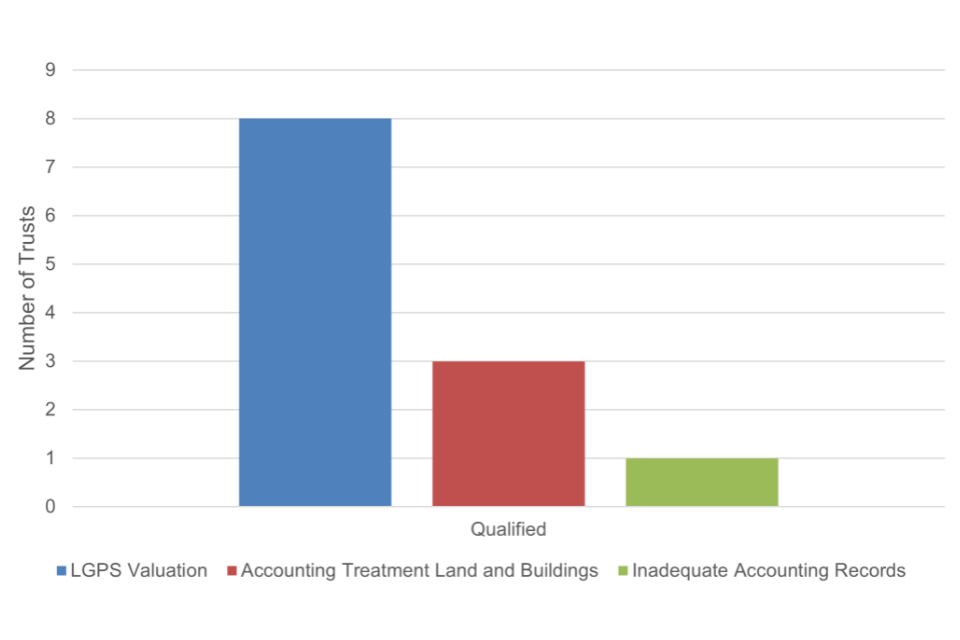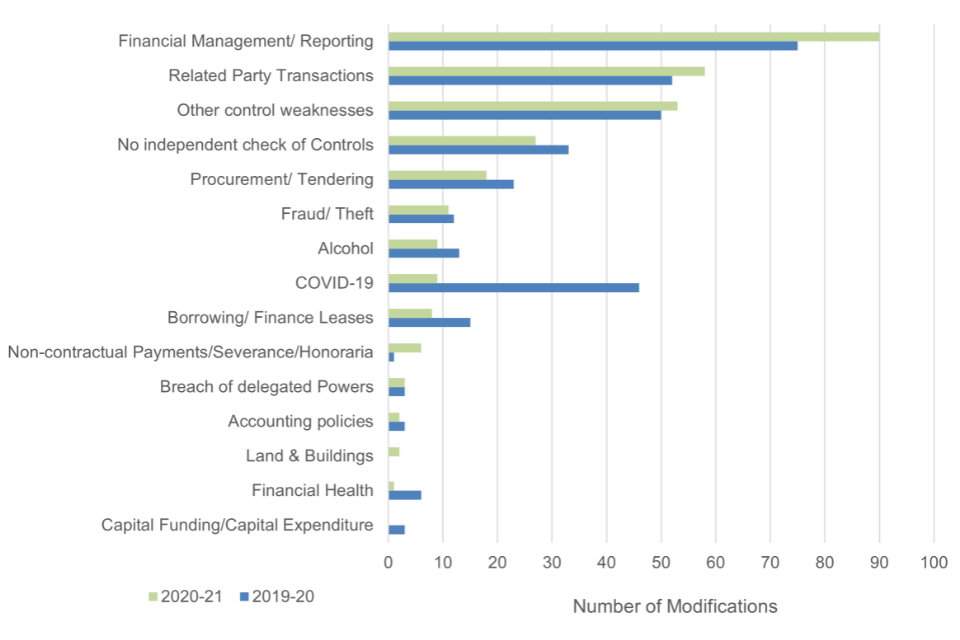Common themes arising from ESFA's assurance work in 2021 to 2022
Updated 11 September 2024
Applies to England
1. Objective
This briefing note provides an overview of the key findings from ESFA’s assurance work in its 2021 to 2022 assurance year, including the review of academy trust financial statements, academy funding audits, financial management and governance reviews and the schools resource management self-assessment checklist (SRM SAC).
2. Review of academy trust financial statements
2.1 Overall findings
In 2020 to 2021 the deadline for trusts to submit their 2019 to 2020 financial statements was extended by one month to the 31 January 2021. For 2021 to 2022 the deadline for submission of 2020 to 2021 financial statements reverted to the 31 December deadline.
By the 31 December 2021 trusts were again required to submit three returns, their audited financial statements, the auditor’s management letter and their annual summary internal scrutiny report.
We found that:
- The percentage of accounts received by 31 December for the 2020 to 2021 trust academic and financial year was just under 97% (for 2019 to 2020 accounts with the deadline 31 January deadline: 97%).
- The main reasons for delays were similar to previous years; trusts closed during the year and had not submitted accounts as part of the closure process and trusts, which were in intervention, had not submitted their accounts by the deadline. At the date of publication, there are 3 trusts, which have not submitted their 2020 to 2021 audited financial statements.
- The percentage of qualified 2020 to 2021 financial statements was 0.5% (2019 to 2020: 0.5%). The main reasons for the qualified opinions were Local Government Pension Scheme (LGPS) valuations and the accounting treatment for land and buildings.
- There was a 0.5% increase in ‘emphasis of matter’ or ‘material uncertainty’ opinions. The main reason for the emphasis of matter opinions continues to be ‘going concern’ because of the trust having closed or proposing to close within the following 12 months. However, there was a 1% decrease in those trusts reporting an ‘emphasis of matter’ or ‘material uncertainty’ opinion due to financial health concerns.
- The percentage of modified regularity opinions in the 2020 to 2021 accounts was 7.9%, which was lower than in the previous year (2019 to 2020: 8.5%). The main issues for the regularity modifications were; no internal scrutiny reviews having been carried out, management accounts not produced and trusts not adhering to the pre-approval requirement for related party transactions with a monetary value of £20,000 or greater.
2.2 Financial statements audit opinions

Figure 1: breakdown of the reasons for qualified opinions

Figure 2: breakdown of the reasons for material uncertainty opinions
2.3 Finanical statements regularity opinions
The highest number of reasons for the modified regularity opinions in 2020/21 accounts related to internal financial reporting, similar to 2019/20 accounts. This is broken down into the following areas:
- management accounts, issues including: not sharing with the Board, not produced and adequacy of the information presented
- financial management issues, where trusts did not document their review of either their trade debtors and / or creditors and / or bank reconciliations
- ESFA deadlines, issues where a trust failed to submit one of the mandated financial returns to ESFA on time
The second highest number of modified regularity opinions was in relation to related party transactions, again, similar to the previous year. This is broken down into the following areas:
- prior approval not sought (not obtained from ESFA for RPTs greater than £20k)
- ‘At cost’ policy not adhered to
- pecuniary interests, issues where declarations were not in place or not published on the trusts’ website

Figure 3: breakdown of the reasons for modified regularity opinions
2.4 Internal scrutiny
Trusts are required to submit an annual summary internal scrutiny report, which should contain the areas reviewed, key findings, recommendations and conclusions.
For some trusts, as with the previous year, an annual summary report was either not submitted, or what was submitted did not meet the minimum requirements, as noted above. Examples of documents submitted that were non-compliant included:
- an extract copied from the governance statement, taken directly from the accounts
- an extract from the external auditor management letter
- minutes from a committee meeting
3. Financial management and governance reviews
Our assurance findings showed that all academy trusts reviewed, were making good progress towards compliance with the Academy Trust Handbook (ATH).
The areas where further development is required include:
- establishing an audit and risk committee, to agree a programme of work to address risks to financial control (internal scrutiny)
- delivery of an appropriate internal scrutiny programme and oversight of the findings
- management accounts, ensuring they contain all required elements, are shared with all trustees six times a year and support appropriate board action to review and maintain financial viability
- trusts maintaining and publishing the register of business and pecuniary interests of its’ trustees and governing structure on their website
- oversight of risk and more regular review of the risk register
4. Academy funding audits
Our funding audits consider error rates relating to both the pupil census numbers, which are used to calculate the main school funding blocks (pre-16 and post-16) and the entitlement to free school meals (FSM) numbers, which is the main factor in determining pupil premium funding (PP). In 2021-22 testing was extended to include additional factors. These factors included:
- EAL (English as an additional language) (pre-16)
- High Value and Premium Courses (post-16)
- PLAC (Post Looked After Children) (PP)
- Service Children (PP)
Despite the additional testing, levels of errors remained low and consistent with previous years.
The pre-16 census data error rate was 0.033% (2020 to 2021: 0%). There were no errors relating to student numbers, which is consistent with the previous year’s result. The only errors found were in relation to EAL, where the schools had not retained sufficient evidence to confirm the learners had been checked. Schools should have a process for checking and recording this data and should retain evidence to support this control is in place.
The post-16 census data error rate was 0.13% (2020 to 2021: 0.56%). There was one isolated error relating to a learner who was ineligible. The learner in question was unable to attend the academy in person, but unfortunately the academy could not provide any evidence to substantiate the learner accessed the ‘online’ training, offered as an alternative. No errors relating to the additional factors - high value courses and maths premium were identified.
For pupil premium funding the overall error rate was 0.87% (2020 to 2021: 0.09%). The errors were FSM errors, where the academies failed to retain evidence to demonstrate that learners’ entitlement to free school meals had been checked at the census point. In some instances, academies were relying on the records held by the previous school and were not carrying out checks themselves.
5. Schools resource management self-assessment checklist (SRM SAC)
Of the 2,546[1] academy trusts expected to submit their SRMSAT, 2,268 (88.9%) submitted by the deadline of 15 April 2022. The response rate at the deadline date was an improvement on last year (2020 to 2021: 82.5% but is still a lower response rate than other financial returns.
The principal areas where trusts were unable to self-assess themselves as compliant were:
- trusts having an appropriate business continuity or disaster recovery plan, including an up-to-date asset register and adequate insurance
- trustees being able to confirm there are no outstanding matters from audit reports
- trust balances are assessed at a reasonable level, and a clear plan is in place for using the money held in balances at the end of each year
- procedures are in place for purchasing goods and services, that both meet legal requirements and secure value for money
At the date of publication, we have received 2,533 (99.5%) of all expected returns.
[1] 2551 academy trusts with an open academy on 31 December 2021 less 5 academy trusts that closed after 1 January 2021
